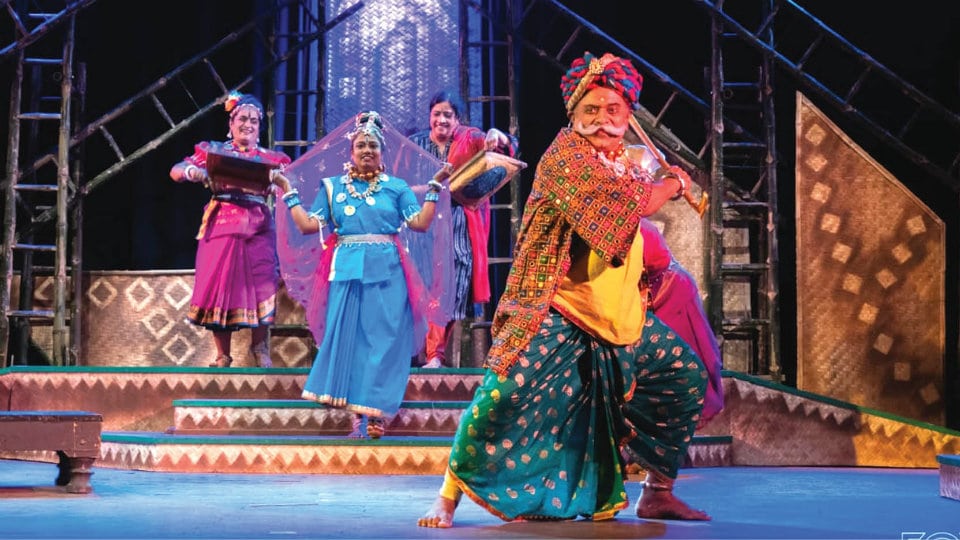The play will be staged at Bhoomigeeta in Rangayana today at 6.30 pm.
The night-flowering jasmine is a little flower that grows on trees. It easily falls with one shove and loses form with any touch that is not delicate. It’s the definition of what we think women are and what is taught to us.
Rangayana Mysuru has summed up the whole thing well in its play ‘Pushpa Parijata’ directed by Sanjay Upadhyaya. The roots of this story are from Shrikant Kishore who adopted it from folklore to a written form. The play speaks of Harbisna and Harbisni, a couple engaged in basket making. They are introduced into the play by K.R. Nandini and Jagdeesh Manvarthe who act as sutradharas for the play. Both are interwoven into the play and weave in and out of the play oh so delicately like a vine and this is a pleasure to watch.
Nandini who is also the assistant director of the play effortlessly blends into the play one among the women in spite fully being in character of the sutradhara and is a picture of grace all throughout the play. Harbisna played by Mahadev and Harbisni played by Pramila Bengre are constantly at loggerheads.
The play attempts to tackle consumerism, the greedy middleman and the poor manufacturer being ripped off. Although shown well by Vinayak Bhat who plays the merchant and Subhash who plays the middleman, they are overshadowed by the love story and the ensuing song and dance routine happening in the background. The plight of the poor manufacturer is relegated to a guest appearance in the entire play as it is overtaken by macro ideas which are thought of to be much more important and have troubled the society since ages.
Harbisna is apple of many a man including the Kotwal, played by an extremely well-suited Prashanth Hiremath. His performance as the Kotwal reminds us of the corrupt and womanising Inspector Satyasheel Satya of Checkmate, another hit play of Rangayana, even though there is enough of originality in the character he has played in this play.
The perpetually drunk Kotwal makes us all laugh with his deputy played by Krishnakumar Narnakaje. Harbisni is also seduced by the King played by Hulugappa Kattimani. He takes the audience to a different cosmos with his energy and cartoon like characterisation of the King. Time flies as he has the audience in the palm of his hand. The King’s love for Harbisni is next only to the love of his gramophone which perpetually worried his wife played by a very adorable Shashikala.
Harbisni is courted by both the Kotwal and the King while Harbisna is away at work trying to make ends meet. The king woos Harbisni and she eventually ends up carrying his child. This is where the sutradharas really shine. They introduce ideas which serve as food for thought for the audience on what is womanhood, parenthood, feminism and what is defined to be a good woman.
A good play not only raises questions but answers them too and this play answers quite a few of them. Harbisni assures the King that even though she bears his child, she will not embarrass him or force him to parent. The evil King throughout the play has his sidekick in the form of a Minister played by Ramu who unable to bear his wickedness eventually kills him. Harbisni is unable to confess to her husband as to whose child she carries. Harbisni in the end bears a child which ends the play.
The play is originally adapted and translated to Kannada by Sadashiv Garud. The adaptation though is quite cliché as like most plays translated into Kannada, they hide in the protective cocoon of Kannada from North Karnataka refusing to come out of the cliché.
As a Mysurean, most of the actors on the stage have been the pride of the city for well over two decades. I do, however, knowing fully well that they are only human, have mixed feelings about some of them having aged albeit gracefully. At any given point of time, there’s too much happening on the stage and it’s quite difficult to keep attention given the fact that there’s live and lively music happening right below the stage.
In the last scene, Harbisni gives birth to a child who explodes out of baskets that make the bedrock of their survival. The child is mirror image of Harbisna playing the Bansuri which indicates that the child though bearing the genes of the King becomes a basket maker like Harbisna.
North India unlike the South has caste system very deeply set and rooted in its folklore and this was proof of the same. With the kind of progressive society that we have and Governments that have been doing so much to uplift the downtrodden, I do have my reservations with the message sent out at the end of the play.
In spite of all said, Rangayana has come out with another crowd-puller. The play entertains the audience and sends them back with questions in their head which will continue to disturb and dwell in them, the hallmark of any good play.
— K. Apoorvananda








Recent Comments